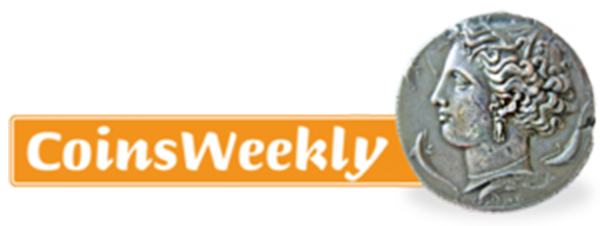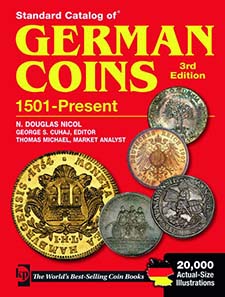by Karsten Dahmen
August 11, 2011 – The fragmentation of the Holy Roman Empire of the German Nation into a rather enormous number of more often tiny entities proved proverbial to contemporaries. With more than 1,800 individual states (from powerful kingdoms, duchies, countships, various principalities and ecclesiastical entities down to individual cities and imperial knights) being part of this empire in the 17th century, not only due to a highly differentiated image of stately organisation and weakened central (i.e. imperial) power, but also a numismatist’s nightmare as far as numbers and especially the diversity of material as well as regional monetary systems are concerned.
N. Douglas Nicol, Standard Catalog of German Coins. 1501-Present. Krause Publishing 2011, 3rd edition, 1488 pages, ISBN 978-1-4402-1402-8. $ 125.
This volume of Krause Publication’s series of catalogues deals with the coinage of Germany and German states from the beginning of the 16th century to the present (earlier editions commenced with the year 1601). The period covered hence ranges from the creation of a huge silver coin as equivalent to the (gold) Gulden, that is from the advent of the Taler and its wide usage during the 16th and 17th centuries, to the downfall of the Empire at hands of Napoleon’s armies in 1806; the various monetary unions among German states (and Austria) in the 19th century to the creation of a united Germany in 1871; the catastrophes of WW I and II and the separation into two German states along the borders of the Iron Curtain; and finally, the fortunate unification of East and West Germany in 1990, followed by the inauguration of the Euro in 2002.
Although, after 1871, the identification of a coin and its issuing authority as ‘German’ will represent no problem, the contrary holds true for earlier times. As the Holy Roman Empire included territories which today belong to France, Belgium, the Netherlands, Switzerland, Poland and others, the decision to include or exclude a certain issue is always delicate and will follow a rather pragmatic approach: hence, while those of present-day Austria are excluded (minted under the authority of the Habsburg emperors), those from German dominated Silesia, which became a part of Prussia only in 1740 when taken from the Austrians, are included; as are coins from Alsace-Lorraine, which fell under French domination at the end of the 17th century and only from 1871-1918 was part of the German Empire.
The second main obstacle to cataloguing and identifying all issues in question is a rather simple one: because of the high number of minting authorities involved, the state of numismatic research into these coins is similarly diverse. Some have recently and satisfyingly been covered by modern research, while for others we still lack up-to-date coin catalogues and mint histories which would provide essential information on mintage numbers, mintmasters, monograms and mintmarks, respectively. Base metal coins and fractions (in contrast to the more precious Taler and gold coins, ducats and gulden) in particular are mostly unpublished yet and await their renewed appreciation in private and museum collections.
The creation of such a ‘Standard Catalog’ from a German perspective, therefore, represents a somewhat daring, but laudable, enterprise, which allows for a number of unanswered questions and imponderability cleared away only with each subsequent edition, much in contrast to the psychology of the German numismatic community and scholarly mind. This is why it comes as no surprise to the reviewer that this catalogue covering 500 years of German coinage was produced in the US rather than in Germany (comparable collectors’ guides in German go back in time only as far as 1700).
Catalogue entries are organised alphabetically by authority/state with the issues of modern Germany beginning in 1871 at page 1432 (except those denominations above 1 Mark produced under the authority of the individual states which constituted the Kaiserreich; for Prussia see page 952, for example). German colonies prior to 1918 appear from page 1485 onwards. German emergency issues (‘Notgeld’), so typical of the post-WW I economic situation until the introduction of the Rentenmark in 1923, have legitimately been excluded from this edition as they represent a similarly diverse subject of their own. Most pre-1871 entries start, not only with a brief historical comment, list of rulers, mint marks, and denominational system, but as a new feature, often include references to specialised numismatic literature.
It is beyond doubt that this ‘Standard Catalog’ strongly benefits from N. Douglas Nicol’s access to German numismatic research and publications in the field. Coins are listed chronologically beginning with the lowest denomination. Mintages are given where available; prices are provided in five grades, though with mintage numbers in most cases lacking, no differentiation for individual annual issues can be provided. In accordance with the series, KM# denotes database numbers (searchable on the Krause website), not subsequent and self-explanatory catalogue numbers within each entity.
A seven page general introductory overview into German monetary history is provided, too. In contrast to earlier editions of 1994 and 1999 and in view of sheer numbers involved, this edition lacks an index of legend abbreviations and an instant identifier of coats of arms and monograms, but offers 500 more pages and 2,000 additional photographs (now adding up to a total 20,000). Apart from that, the book places a stronger emphasis on the inclusion of minor denominations. With nearly 1,500 pages in one volume, this edition will have reached the limits of practicability.
Being a compilation of known (and published) types combined with valuations, this 3rd edition of the ‘Standard Catalog of German Coins 1501 to Present’ constitutes an extremely helpful and appreciable tool for anybody collecting and handling German coins or dealing in German numismatics. Besides being the only existing reference of this kind so far (compare the reasons mentioned above), it provides the first and most elementary step into the appreciation of the subject.
Those who come across German coins only occasionally will find enough information to identify their coin and its place in history while those with more specialised interest will take the second step into the specific secondary literature from this base. I am looking forward to intensive usage of this catalogue’s 3rd edition in the years to come, which will help in creating an even better fourth edition with some minor errors eliminated, more types added, and additional references provided.
If you wish to order this book or inform you on Krause Publishing, visit this site.





